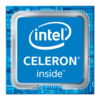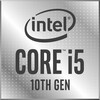Intel Celeron N4500 vs Intel Core i5-1035G1
Intel Celeron N4500
► remove from comparison
The Intel Celeron N4500 is a dual-core SoC of the Jasper Lake series that is primarily intended for inexpensive notebooks and was announced in early 2021. The two Tremont CPU cores clock between 1.1 and 2.8 GHz (single core Burst) and offer no HyperThreading. The N4500 uses 1.5 MB L2 and 4 MB L3 cache. The chip is manufactured on the first-gen 10 nm Intel process.
Architecture
The processor architecture is called Tremont and a complete redesign compared to the old Golmont Plus cores in the predecessor. According to Intel, the single thread performance of a core could is up two 30% better on average (10 - 80% in all tests of SPECint and SPECfp).
Features
In addition to the dual-core CPU block, the SoC integrates a 16 EU Intel UHD Graphics GPU clocked from 350 - 750 MHz and a dual-channel DDR4 / quad-channel LPDDR4(x) memory controller (up to 16 GB, up to 2933 MHz). The chip now also partly integrates Wi-Fi 6 (Gig+), 8 PCIe 3.0 lanes, 14 USB 2.0/ 3.2 ports and two SATA 6.0 ports. The package got bigger and measures 35 x 24 mm (compared to 25 x 24 mm for the N5030 e.g.). The SoC is directly soldered to the mainboard (BGA) and can't be easily replaced.
Performance
The average N4500 in our database shapes up to be a fairly slow processor, its multi-thread benchmark scores only just matching those of the Core i3-4010U. (The latter saw the light of day in 2013 as a lower mid-range, dual-core CPU designed for use in ultraportable laptops.) In other words, expect the Celeron to be painfully slow in all but the most basic activities.
You mileage may vary depending on how high the CPU power limits are.
Power consumption
Like most N-class Intel chips, the Celeron has a default TDP (also known as the long-term power limit) of 6 W. This is not much at all and thus good enough for passively cooled tablets, laptops, mini-PCs.
The Celeron N4500 is built with Intel's 2nd generation 10 nm process (not 10 nm SuperFin or Intel 7) for low, as of mid 2023, energy efficiency.
Intel Core i5-1035G1
► remove from comparison
The Intel Core i5-1035G1 is a low-power, Ice Lake family processor (SoC) featuring 4 cores, 8 threads, 6 MB of L3 cache and the UHD G1 (32 EUs) iGPU. It saw the light of day in H2 2019. The chip is designed for use in highly portable laptops; its CPU cores run at 1.0 GHz to 3.6 GHz, with only 3.2 GHz achievable if all the cores are loaded.
Unlike the costlier Core i5-1035G4, the 1035G1 has the 32 EU UHD Graphics G1 iGPU at its disposal as opposed to the more powerful 48 EU Iris Plus G4; CPU cores run at a slightly lower clock rate in the case of the 1035G1, too.
Architecture & Features
Ice Lake family chips are powered by Sunny Cove CPU cores.The latter aim to do what Palm Cove cores (that we never really got a chance to get a taste of) were expected to do, delivering a double-digit IPC uplift over the venerable Skylake architecture thanks to a range of small improvements across the board including scheduler improvements, larger caches and buffers, and support for new instruction sets.
Thunderbolt 3 support is built right into the Core i5 (meaning the latter has several PCIe 3 lanes exclusive to Thunderbolt devices, reducing the number of additional components required for Thunderbolt to work) and so is Intel CNVi Wi-Fi 6 support (making it easier for Intel to sell its proprietary WLAN cards to laptop makers). The Core i5-1035G1 also has the DL Boost and GNA features for applications centered around machine learning.
The 4 GT/s bus is indicative of a consumer-grade chip, since CPUs for gaming laptops and portable workstations usually employ the faster 8 GT/s bus. RAM support is nothing to sneeze at, at up to DDR4-3200 or LPDDR4-3733. NVMe SSDs are supported, with data transfer rates limited to 3.9 GB/s (this is what four PCIe 3 lanes are good for). SATA drives and even eMMC chips are also natively supported here.
This is not a user-replaceable CPU, as it gets permanently soldered to the motherboard (BGA1526 socket interface).
OS support is limited to 64-bit Windows 10 and Windows 11, as well as many Linux distros.
Performance
The Core i5-1035G1 is a lower mid-range CPU, as of mid 2022. It is good for more than just the basics while being no match for true high-performers such as the mighty Core i7-10850H.
According to our in-house testing, the Core i5 delivers multi-thread performance that is similar to what the Core i7-10610U, the Core i7-1160G7 and the Ryzen 5 PRO 3500U have to offer. Your mileage may vary depending on how competent the cooling solution of your system is and how high the CPU power limits are.
The Lenovo IdeaPad 5 15IIL05 is among the fastest laptops featuring the 1035G1 that we have tested.
Graphics
The UHD Graphics G1 is based on Intel's Gen 11 architecture. The UHD Graphics runs at up to 1,050 MHz and has 32 EUs for fairly unimpressive performance; the Iris Plus G4 has 48 EUs while the Iris Plus G7 has 64 EUs, for reference. This iGPU will drive up to 3 monitors simultaneously and is DX12-compatible. The resolution options are capped at 5120 by 3200. There is no hardware AV1 codec support here, meaning such a video will be SW-decoded with rather low energy efficiency. The usual HEVC, AVC and VP9 codecs are supported, thankfully.
The UHD Graphics is significantly faster than the UHD Graphics 620, yet it's still not as good as a proper discrete graphics card would be. It will let one play certain games, F1 2020 included, provided one is content with the 720p resolution and low quality settings.
Power consumption
The Core i5-1035G1 has a default TDP (also known as the long-term Power Limit) of 15 W. Laptop makers are free to increase that value somewhat, with 25 W being the upper limit, or reduce it (values as low as 13 W are possible). Clock speeds and performance will change accordingly as a result. Either way, an active cooling solution will be required to dissipate the heat.
The chip is manufactured on Intel's second-generation 10 nm process (not "10 nm SuperFin" or "Intel 7") for average, as of late 2022, energy efficiency.
| Model | Intel Celeron N4500 | Intel Core i5-1035G1 | ||||||||||||||||||||||||||||||||||||||||||||||||||||||||
| Codename | Jasper Lake | Ice Lake-U | ||||||||||||||||||||||||||||||||||||||||||||||||||||||||
| Series | Intel Jasper Lake | Intel Ice Lake | ||||||||||||||||||||||||||||||||||||||||||||||||||||||||
| Series: Ice Lake Ice Lake-U |
|
| ||||||||||||||||||||||||||||||||||||||||||||||||||||||||
| Clock | 1100 - 2800 MHz | 1000 - 3600 MHz | ||||||||||||||||||||||||||||||||||||||||||||||||||||||||
| L2 Cache | 1.5 MB | 2 MB | ||||||||||||||||||||||||||||||||||||||||||||||||||||||||
| L3 Cache | 4 MB | 6 MB | ||||||||||||||||||||||||||||||||||||||||||||||||||||||||
| Cores / Threads | 2 / 2 | 4 / 8 | ||||||||||||||||||||||||||||||||||||||||||||||||||||||||
| TDP | 6 Watt | 15 Watt | ||||||||||||||||||||||||||||||||||||||||||||||||||||||||
| Technology | 10 nm | 10 nm | ||||||||||||||||||||||||||||||||||||||||||||||||||||||||
| max. Temp. | 105 °C | 100 °C | ||||||||||||||||||||||||||||||||||||||||||||||||||||||||
| Socket | BGA1338 | BGA1526 | ||||||||||||||||||||||||||||||||||||||||||||||||||||||||
| Features | DDR4-2933/LPDDR4x-2933 RAM, PCIe 3, GNA, MMX, SSE, SSE2, SSE3, SSSE3, SSE4.1, SSE4.2, SMEP, SMAP, EIST, TM1, TM2, Turbo, SST, AES-NI, RDRAND, RDSEED, SHA | DDR4-3200/LPDDR4-3733 RAM, PCIe 3, 4 GT/s bus, DL Boost, GNA, MMX, SSE, SSE2, SSE3, SSSE3, SSE4.1, SSE4.2, AVX, AVX2, AVX-512, BMI2, ABM, FMA, ADX, VMX, SMEP, SMAP, EIST, TM1, TM2, Hyper-Threading, Turbo, SST, AES-NI, RDRAND, RDSEED, SHA, SGX | ||||||||||||||||||||||||||||||||||||||||||||||||||||||||
| iGPU | Intel UHD Graphics (Jasper Lake 16 EU) (350 - 750 MHz) | Intel UHD Graphics G1 (Ice Lake 32 EU) (300 - 1050 MHz) | ||||||||||||||||||||||||||||||||||||||||||||||||||||||||
| Architecture | x86 | x86 | ||||||||||||||||||||||||||||||||||||||||||||||||||||||||
| Announced | ||||||||||||||||||||||||||||||||||||||||||||||||||||||||||
| Manufacturer | ark.intel.com | ark.intel.com | ||||||||||||||||||||||||||||||||||||||||||||||||||||||||
| L1 Cache | 192 KB |
Benchmarks
Average Benchmarks Intel Celeron N4500 → 100% n=33
Average Benchmarks Intel Core i5-1035G1 → 319% n=33
* Smaller numbers mean a higher performance
1 This benchmark is not used for the average calculation













